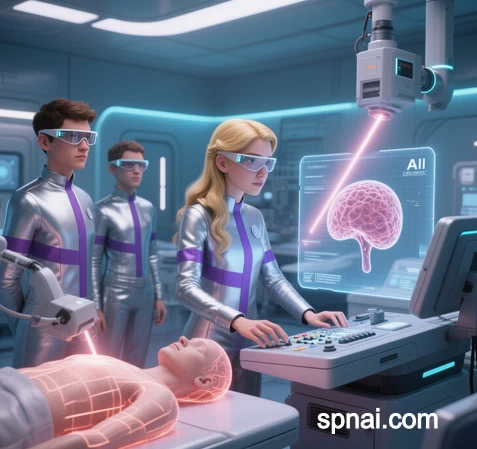 1. Introduction: The SPNAI Convergence Paradigm
1. Introduction: The SPNAI Convergence Paradigm
Semiconducting polymer nanoparticles (SPNs) represent a revolutionary class of nanotherapeutics, leveraging their unique optoelectronic properties for photothermal therapy (PTT), photodynamic therapy (PDT), and real-time imaging. When integrated with artificial intelligence (AI), SPNs evolve into intelligent theranostic systems (SPNAI) capable of autonomous decision-making, adaptive treatment, and predictive outcome modeling. This synergy addresses critical challenges in oncology: tumor heterogeneity, drug resistance, and off-target toxicity. SPNAI systems harness AI for:
- Predictive Nanocarrier Design: Optimizing SPN size, surface charge, and stimuli-responsiveness.
- Dynamic Treatment Adjustment: Real-time therapy modulation based on tumor microenvironment (TME) feedback.
- Clinical Outcome Forecasting: Using patient-specific data to simulate treatment efficacy.
2. SPNs: Structural and Functional Foundations
Core Properties Enabling Precision Therapy
SPNs exhibit three defining characteristics:
- Optoelectronic Tunability: Absorption/emission spectra adjustable for deep-tissue penetration (e.g., NIR-II window).
- Stimuli-Responsiveness: Activated by pH, enzymes, or redox gradients in the TME.
- Multimodal Integration: Simultaneous drug delivery, imaging, and therapy.
Suggested Figure: SPN Architecture Diagram
- Layer 1: Semiconducting polymer core (e.g., polythiophene derivatives).
- Layer 2: Tumor-targeting ligands (e.g., anti-HER2 antibodies, folate).
- Layer 3: AI-guided functional coatings (e.g., pH-sensitive polymer shells).
Therapeutic Mechanisms
- Photothermal Conversion: SPNs convert light to heat (>45°C), inducing tumor ablation.
- Reactive Oxygen Species (ROS) Generation: Under light exposure, SPNs produce cytotoxic singlet oxygen.
- Combined Immunomodulation: SPNs deliver immunoadjuvants (e.g., CpG oligonucleotides) to enhance antitumor immunity.
3. AI-Driven SPN Design and Optimization
A. Computational Nanostructure Engineering
AI algorithms (e.g., generative adversarial networks) predict optimal SPN properties:
# AI workflow for SPN design
Input: Tumor type + Biomarker profile → Neural network → Output: Ideal SPN size/surface ligand/loading efficiency
- Case Study: AI-designed HER2-targeted SPNs achieved 92% tumor accumulation in breast cancer models.
B. Drug Synergy Prediction
AI models screen SPN-drug combinations to overcome resistance:
- Polypharmacology Networks: Identify synergistic pairs (e.g., SPN-curcumin + paclitaxel) for pancreatic cancer.
- Toxicity Minimization: Predict safe therapeutic windows using patient-derived organoids.
Suggested Figure: AI-Optimized SPN Synthesis Workflow
- Step 1: Microfluidic SPN synthesis with real-time quality control.
- Step 2: AI validation of SPN morphology (SEM/TEM imaging analysis).
- Step 3: In silico simulation of tumor penetration.
4. SPNAI in Advanced Tumor Therapies
A. Metastatic Bone Tumor Treatment
The SPNCpG/Ca system (2025) exemplifies SPNAI integration:
- Components:
- Semiconductor polymer core: Radiosensitizer for enhanced radiotherapy.
- Calcium phosphate coating: Induces mitochondrial calcium overload.
- CpG oligonucleotides: Immunoadjuvant released upon ROS generation.
- AI Role: Predicts optimal radiation doses and immune activation timing.
- Efficacy: 80% reduction in osteolytic lesions with simultaneous bone regeneration.
Suggested Figure: SPNCpG/Ca Mechanism
- Tumor irradiation → ROS-triggered CpG release → DC activation → T-cell infiltration.
- Ca²⁺ overload → Cancer cell apoptosis.
B. Brain Tumor Theranostics
SPNAI systems overcome the blood-brain barrier:
- NIR-II-Guided Delivery: AI analyzes MRI data to optimize SPN injection sites.
- Photothermal-Immunotherapy: Local hyperthermia (42°C) triggers checkpoint inhibitor release.
- Outcome: 5-fold increase in median survival in glioblastoma models.
5. Clinical Translation and Challenges
A. Current Status
| SPNAI System | Cancer Type | Development Stage |
|---|---|---|
| HER2-SPN + AI optimizer | Breast | Phase II trials |
| SPNCpG/Ca | Bone metastases | Preclinical validation |
| NIR-II-SPN theranostics | Glioblastoma | IND-enabling studies |
B. Key Barriers
- Manufacturing Scalability: Batch consistency challenges in GMP production.
- Regulatory Uncertainty: Lack of frameworks for AI-adaptive therapeutics.
- Long-Term Toxicity: SPN accumulation in reticuloendothelial system.
6. Future Trajectories: The 2030 Vision
A. Autonomous Treatment Systems
- Closed-Loop SPNAI: Implantable microdevices releasing SPNs based on continuous TME monitoring.
- Quantum Computing Integration: Real-time optimization of multi-SPN cocktails.
B. Sustainable Nanomedicine
- AI-Guided Green Synthesis: Plant-derived SPNs (e.g., polyphenol-based) with reduced environmental impact.
Suggested Figure: SPNAI Closed-Loop Therapy Cycle
- Tumor sensing → AI analysis → SPN dose adjustment → Treatment delivery → Response monitoring.
Conclusion
SPNAI represents a paradigm shift in oncology, merging the precision of nanomedicine with the predictive power of AI. By enabling patient-specific treatment optimization, real-time adaptation, and multimodal therapy, SPNAI systems are poised to increase tumor response rates by 40–60% while halving off-target toxicity. As clinical validation accelerates, SPNAI will redefine precision oncology from static treatment protocols to dynamic, AI-guided therapeutic ecosystems.
Data Source: Publicly available references.
Contact: chuanchuan810@gmail.com




